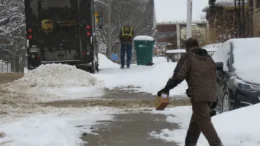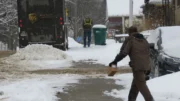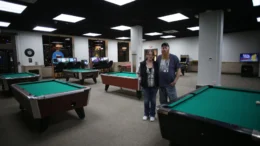Just a little over a century ago, there was a whole lot of knitting and sewing going on upstairs in the Oil City Library.
The mission – sweaters, scarves, bed linens, towels and more for local soldiers, sailors and Marines serving overseas in World War I.
An ongoing effort to rid old stored items in what was once a splendid auditorium/theater area on the library’s second floor recently yielded half a dozen old ledger books.
It was a fitting effort for the Red Cross chapter that originated out of a local society formed in July 1898 during the Spanish-American War. Oil City nurse Olivia Fisher asked her hometown to produce bandages and supplies for the troops.
The unit became a Red Cross chapter in 1909 and was the first such chapter to be chartered in northwest Pennsylvania.
‘Placed on a war footing’
In February 1917, Fisher, who was chapter executive director, again organized volunteers to do war work for World War I. The city chapter was identified as the first Red Cross chapter in the U.S. to “be placed on a war footing” in World War I.
That translated into a major effort to pull out the knitting needles, man the sewing machines and more for the Oil City Red Cross. Rooms were set up at the YMCA and a space reserved upstairs in the library, then known as the Carnegie Library, for the project. More space was available at the home of Myra Chickering, Red Cross chapter chairman, on West Third Street.
Each multi-page ledger lists the names of individuals as well as more than 50 groups that stepped up to help. The Red Cross would purchase the materials that included yarn, linen, flannel, khaki, cotton and wool and then distribute them, at cost, to the volunteer seamstresses and knitters. In return, the materials would be transformed into scarves, sweaters, pajamas, helmet liners, socks, under-drawers, undershirts and other clothing.
In addition, the production included bed linens, wash cloths, operating gowns and masks and bandages for both overseas shipments as well as donations to the local hospitals, infirmaries, the Grandview Tuberculosis Sanitarium in Oil City and elsewhere.
Most, though, were destined for overseas shipment to American troops.
“The Red Cross has been assisting military members since before Clara Barton so we were poised to get things to them,” said Mary Rogers, executive director of the Oil City Red Cross chapter. “We always had a national network with the ability to do that and we still do. So I imagine the Red Cross sent all these things out.”
Units and individuals
There are distribution and return entries in the ledgers. For example, the Rockland Auxiliary was given 11 pounds of cotton fabric on Feb. 23, 1918. Just below that entry is one that notes Nellie Ferran took “a small ball gray (yarn).” In the return column, volunteers were credited with their creations. For example, the Tionesta Branch turned in ” four pairs of pajamas, 26 blouses, 10 chemises” on July 3, 1917.
“The Oil City chapter had units and they reached out to other communities,” said Rogers. “I would assume those groups, including the churches, were contributing to the Red Cross effort.”
The listing of volunteer organizations that pitched into the World War I relief campaign included those identified as Petroleum Center, Brredinsburg Auxiliary, Endeavor Branch, Salina Auxiliary, Business Women’s Club, Salvation Army, Scrubgrass Auxiliary, King’s Daughter Bible Class, Rynd Farm Auxiliary, Easter Star, DAR, 1st Presbyterian Auxiliary, Crystal Springs, Junior High and East End WCTU.
The individuals, all women and each identified in the ledger only as Mrs. and her last name, as was typical in the social mores of 1917, included the wives of local shopkeepers, oil industry leaders, bankers, philanthropists, factory workers, ministers, teachers and many others.
The ledgers were given to the Oil City Red Cross chapter for its archives.
“We are always finding treasures up here,” said Sarah Margherio, chairman of a library-based theater restoration committee that is working to empty the space and launch a restoration project.





























